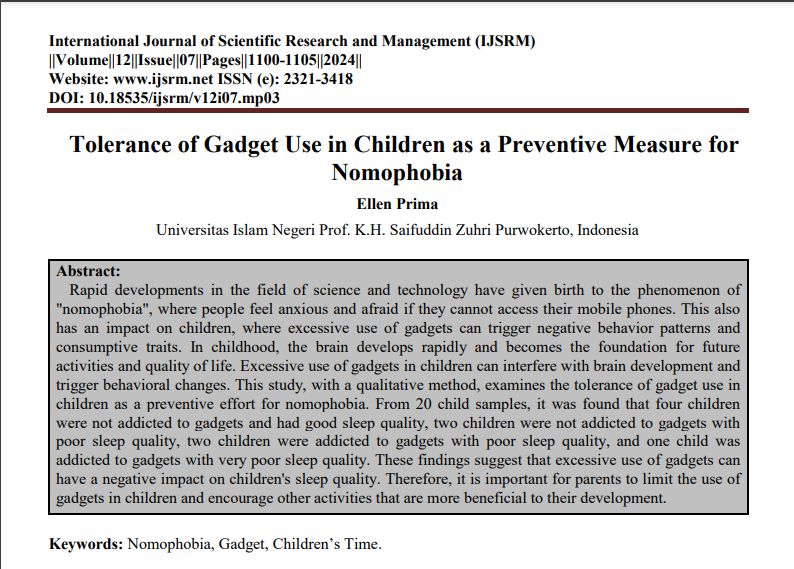
Submission to VIJ 2024-07-17
Keywords
- Nomophobia,
- Gadget,
- Children’s Time
Copyright (c) 2024 Ellen Prima

This work is licensed under a Creative Commons Attribution 4.0 International License.
Abstract
Rapid developments in the field of science and technology have given birth to the phenomenon of "nomophobia", where people feel anxious and afraid if they cannot access their mobile phones. This also has an impact on children, where excessive use of gadgets can trigger negative behavior patterns and consumptive traits. In childhood, the brain develops rapidly and becomes the foundation for future activities and quality of life. Excessive use of gadgets in children can interfere with brain development and trigger behavioral changes. This study, with a qualitative method, examines the tolerance of gadget use in children as a preventive effort for nomophobia. From 20 child samples, it was found that four children were not addicted to gadgets and had good sleep quality, two children were not addicted to gadgets with poor sleep quality, two children were addicted to gadgets with poor sleep quality, and one child was addicted to gadgets with very poor sleep quality. These findings suggest that excessive use of gadgets can have a negative impact on children's sleep quality. Therefore, it is important for parents to limit the use of gadgets in children and encourage other activities that are more beneficial to their development.
References
- Hardianti, F., Kuswarno, E., & Sjafirah, N. A. (2019). Nomofobia dalam Perspektif Media, Budaya, dan Teknologi. Jurnal Teknologi Dan Pendidikan, 18(2), 182–196.
- Irfan, Aswar, & Erviana. (2020). Hubungan Smartphone dengan Kualitas Tidur Remaja di SMA Negeri 2 Majene. Jurnal of Islamic Nursing, 5(2), 95–100.
- Iswidharmanjaya, D. (2014). Bila Si Kecil Bermain Gadget. Bisakimia.
- Mayangsari, A. P., & Ariana, A. D. (2015). Hubungan antara Self-Esteem dengan Kecenderungan Nomophobia pada Remaja. Jurnal Psikologi Klinis Dan Kesehatan Mental, 4(3), 157–163.
- Nugroho, A. (2013). Teknologi Komunikasi. Graha Ilmu.
- Nurhaeda. (2018). Dampak Penggunaan Gadget Pada Anak Usia Dini Dalam Pandangan Islam Di PAUD Terpadu Mutiara Hati Palu. Early Childhood Education Indonesian Journal, 1(2), 70–78.
- Okitasari, W. (2021). Pengaruh Penggunaan Gadget Terhadap Pengembangan Pendidikan dan Karakter Budaya Anak Bangsa. Jurnal Pendidikan Nusantara, 2(1), 17–28.
- Rahayuningrum, D. C., & Sary, A. N. (2019). Studi Tingkat Kecemasan Remaja Terhadap No-Mobila Phone (Nomophobia). Jurnal Keperawatan BSI, VII(1), 49–55.
- Rosyidi, M. F. A. A. M. (2019). Konsep Toleransi dalam Islam dan Implementasinya di Masyarakat Indonesia. Jurnal Madaniyah, 9(2), 277–296.
- Sari, I. P., Ifdil, I., & Yendi, F. M. (2020). Konsep Nomophobia pada Remaja Generasi Z. JRTI (Jurnal Riset Tindakan Indonesia), 5(1), 21–26.
- Setianingsih, Ardani, A. W., & Khayati, F. N. (2018). Dampak Penggunaan Gadget Pada Anak Usia Dini Pra Sekolah Dapat Meningkatkan Resiko Gangguan Pemusatan Perhatian Dan Hiperaktivitas. GASTER, XVI(2), 191–205.
- Suana, & Firdaus. (2014). Pola Asuh Orang Tua Akan Meningkatkan Adaptasi Sosial Anak Prasekolah di RA Muslimat NU 202 Assa’adah Sukowati Bungah Gresik. Jurnal Ilmiah Kesehatan, 7(2), 180–185.
- Sugiyono. (2015). Metode penelitian pendidikan : Pendekatan kuantitatif, kualitatif, dan R&D (21st ed.). Alfabeta.